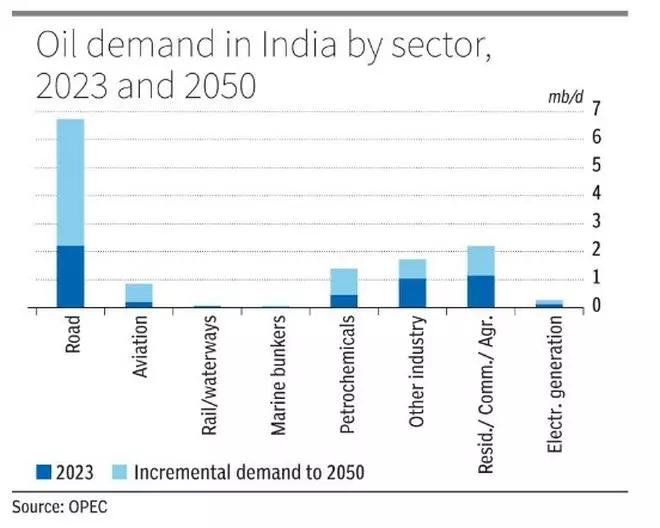Oil demand in India, world’s third largest crude oil importer, is likely to grow by 8 million barrels per day (mb/d) between 2023 and 2050, which is the highest rate of growth globally, OPEC’s World Oil Outlook (WOO) report reveals.
According to the WOO 2050, oil demand in the world’s fastest growing emerging economy is expected to grow from 5.3 mb/d in 2023 to 13.3 mb/d in 2050.
“Extending the outlook’s time horizon to 2050 amplifies the role of India, Other Asia, Africa and the Middle East as the key sources of incremental demand in the coming years, the report said.

“Combined demand in these four regions is set to increase by 22 mb/d between 2023 and 2050. India alone will add 8 mb/d to its oil demand during the forecast period. China’s oil demand is projected to increase by 2.5 mb/d,” it added.
- Also read: Crude Check: Exhibits bullish signs
Sectors pushing up demand
India’s current oil demand composition is characterised by a relatively high share of diesel/ gasoil, which accounts for around 35 per cent of total demand. In fact, the share of diesel/ gasoil is set to expand to 38 per cent by 2040 before declining to 37 per cent in 2050, mainly due to expanding freight transport and industrial production.
Some demand growth for this product also comes from the petrochemical industry, as well as the commercial and agriculture sectors. Accordingly, diesel demand is projected to increase by 3 mb/d, from around 1.9 mb/d in 2023 to 4.9 mb/d in 2050.
OPEC’s World Oil Outlook till 2050 projects that road transportation constitutes the primary key area where more than half of the overall demand increase is expected to materialise.
“This will be mainly driven by the significant expansion of the country’s passenger car fleet, from less than 50 million in 2023 to more than 240 million in 2050 (excluding two-wheelers). Moreover, the number of commercial vehicles is set to more than quadruple during the period to 2050, on the back of strong GDP growth,” it added.
EV impact
At the same time, the penetration of EVs will likely remain subdued in India, therefore, a large majority of ICE-powered vehicles will provide support to strong oil demand growth in this sector, it added.
The second largest demand increase is projected in the residential, commercial and agricultural sectors combined, expanding from 1.2 mb/d in 2023 to 2.2 mb/d in 2050.
Part of this demand increase is linked to the extended use of agriculture machines and fertilizers. Expanding population and urbanisation is set to result in the more widespread use of LPG and gasoil in the residential and commercial sectors.
Part of the potential growth in these sectors, however, will likely also be met by other energy sources, such as electricity and natural gas.
In particular, residential oil demand will face competition in areas where natural gas access improves, as part of the ongoing City Gas Distribution programme, which is government supported.
Rationale
Even though India’s population level is comparable to China, its current oil demand is around one-third of China’s. It is significantly lower compared to Latin America, which is twice as less populous.
“This indicates the huge potential for future demand growth in this country, especially considering continued strong economic growth and an ever expanding population,” the WOO pointed out.
This Outlook assumes that India’s GDP will grow by 5.9 per cent per annum on average between 2023 and 2050, remaining robust even towards the end of the outlook period.
According to the latest estimates from UNDESA, India’s population is set to increase by 242 million by 2050. With a projected population of 1.68 billion in 2050, it will be by far the most populous country in the world.
Besides this significant increase, around half of India’s population is below the age of 25, providing an additional boost to economic activity. As a result, India’s working population is expected to expand to more than 1.1 billion by 2050, it added.
Moreover, the expected increase in urbanization rate will also play an important role. With many policy interventions in recent years, such as the Smart Cities Mission initiative, the construction of affordable rental housing complexes and the adoption of rapid transport metro systems in larger cities, India’s urbanisation rate is set to increase considerably during the outlook period. In turn, this will support demand growth for modern energy sources, including oil.





Comments
Comments have to be in English, and in full sentences. They cannot be abusive or personal. Please abide by our community guidelines for posting your comments.
We have migrated to a new commenting platform. If you are already a registered user of TheHindu Businessline and logged in, you may continue to engage with our articles. If you do not have an account please register and login to post comments. Users can access their older comments by logging into their accounts on Vuukle.